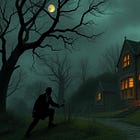The Confabulannotated Sherlock Holmes, Chapter 3.8
Featuring calligraphic calculus, astral projection and meta-comedy
NOTE: If you have received this via email, you may find it easier to read the confabulannotations online by clicking on the title above.
Previously on my confabulannotations of Sir Arthur Conan Doyle’s Sherlock Holmes mystery, The Hound of the Baskervilles: Watson returned to a smoke-filled room
And now, the story continues…
“Well, it is rather obvious.”
“The world is full of obvious things which nobody by any chance ever observes1. Where do you think that I have been?”
“A fixture also2.”
“On the contrary, I have been to Devonshire3.”
“In spirit?”
“Exactly. My body has remained in this armchair and has, I regret to observe, consumed in my absence two large pots of coffee and an incredible amount of tobacco4. After you left I sent down to Stamford’s for the Ordnance map of this portion of the moor, and my spirit has hovered over it all day. I flatter myself that I could find my way about5.”
“A large-scale map, I presume?”
“Very large6.”
He unrolled one section and held it over his knee. “Here you have the particular district which concerns us. That is Baskerville Hall in the middle.”
“With a wood round it?”
“Exactly. I fancy the yew alley, though not marked under that name, must stretch along this line, with the moor, as you perceive, upon the right of it. This small clump of buildings here is the hamlet of Grimpen7, where our friend Dr. Mortimer has his headquarters. Within a radius of five miles there are, as you see, only a very few scattered dwellings. Here is Lafter Hall, which was mentioned in the narrative8. There is a house indicated here which may be the residence of the naturalist—Stapleton, if I remember right, was his name. Here are two moorland farmhouses, High Tor and Foulmire9. Then fourteen miles away the great convict prison10 of Princetown. Between and around these scattered points extends the desolate, lifeless moor. This, then, is the stage upon which tragedy has been played, and upon which we may help to play it again.”
TO BE CONTINUED
For example, a teenager on public transport using their headphones while watching their godawful TikToks. Or Mr Snuffleupagus.
‘Where Do You Think That I Have Been?’ was a game played by sophisticated gentlemen of the era, in which the Question-Receiver would have to reply using a sentence that did not name a specific location, but also contained an equal number of vowels and consonants. This response would have been considered exceptionally good play by Watson, with Holmes now called upon to name an anagrammatic location or concede the point.
1-0 to Watson. (A winning play from Holmes would have been ‘Lauxia Forest’. Frankly, ‘Devonshire’ isn’t even close.)
The first half of this paragraph is one of the more brazen fakeouts in the Holmes canon, positing not only that the great detective has the Dr Strange-like ability to traverse the spiritual plane, but also that his soulless shell remains so enslaved by caffeine and nicotine addiction that it will remain in consumptive motion even in the absence of his life essence.
And then it turns out he just asked somebody to fetch him a map.
Calligraphy had undergone a mathematical revolution around this time, and theoretical mapmakers had made great progress towards proving a variety of conjectures about the optimal size of a map. Indeed, Dr Silas Quillcraft, a professor of Calligraphic Calculus at Oxford had already proven, from a general set of axioms, that the optimal ratio was smaller than 1:1, and it is therefore safe to assume that Holmes’ ‘very large’ map was still below this upper limit.
Prince Hamlet of Denmark was named after Hamlet of Grimpen, who was not of royal blood, but did once help Shakespeare mend a door handle.
A fine self-aware moment from Holmes, referring back to Chapter Two, and perhaps suggesting that, despite its lowbrow reputation, meta-comedy was a go-to brand of humour at the previously discussed misspelled comedy club of Lafter Hall.
The decision to name one’s farmhouse ‘foul mire’ suggests that the dwelling in question was built during the Great Reverse Psychology Real Estate Boom of the early 1800s. This, in turn, raises serious questions about the dimensions of the other farmhouse.
Is this a prison for great convicts? Or a convict prison imbued with greatness? Alas, Conan Doyle does not make this clear.


